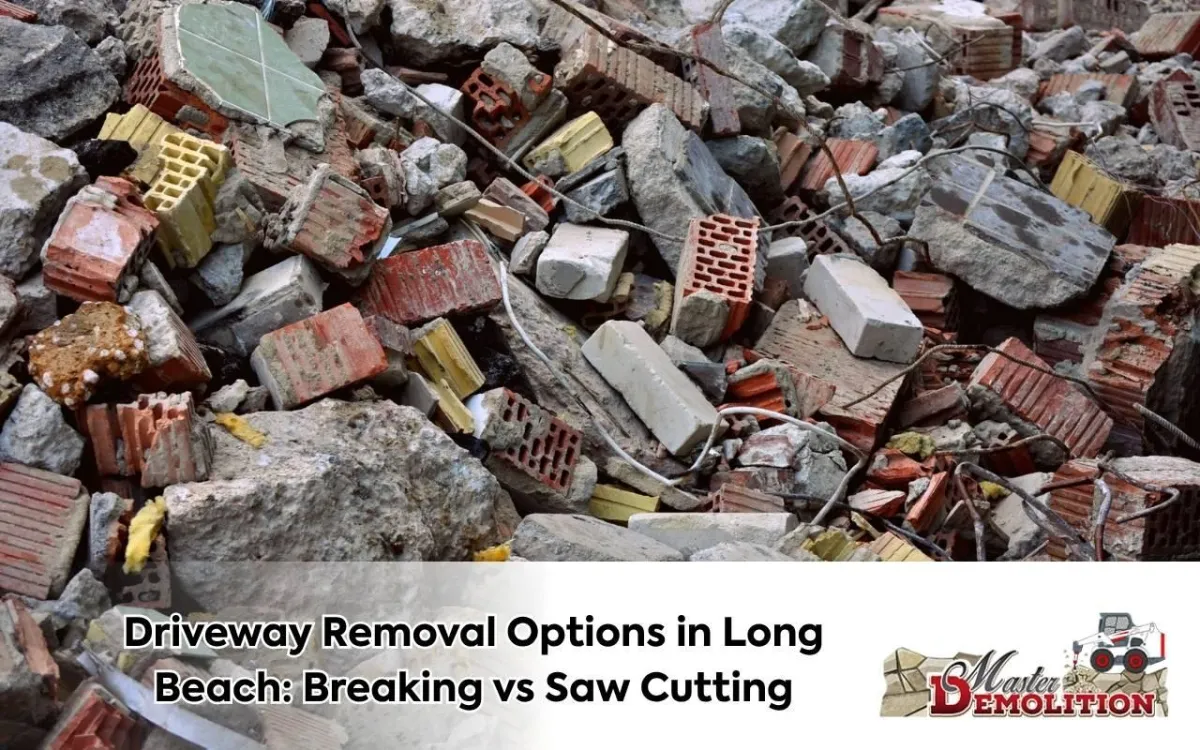
Driveway Removal Options in Long Beach: Breaking vs Saw Cutting
When considering driveway removal options in Long Beach, property owners must choose between breaking and saw cutting. Each method carries unique benefits and challenges. Factors such as slab thickness, rebar mesh, and noise greatly impact the outcome. Urban living demands minimizing disruption, making careful selection crucial for smooth execution and satisfaction.
Breaking is fast, but saw cutting provides precision and reduced noise. Disposal and surface preparation are also vital considerations. Making an informed choice ensures that your project’s timeline, quality, and neighborhood harmony remain intact. This guide explores both methods to help you decide effectively.
Factors to Consider Before Choosing a Driveway Removal Method
Selecting the right approach for driveway removal options in Long Beach requires thoughtful evaluation. Contractors assess slab thickness, rebar mesh density, noise regulations, and disposal logistics. These variables influence efficiency and compliance. Accessibility also matters in tightly packed Long Beach properties.
Slab thickness determines whether breaking or sawing is more efficient.
Rebar mesh density impacts cutting or breaking time and equipment wear.
Noise ordinances may favor quieter saw cutting over breaking.
Surface prep and disposal logistics affect overall project efficiency.
Partnering with a skilled demolition team ensures balance between speed, compliance, and budget. For professional guidance, visit our demolition services page.
The Process of Breaking for Driveway Removal
Breaking begins with marking manageable slab sections. Jackhammers or pneumatic breakers fracture concrete along lines, creating removable chunks. Crews transport debris with wheelbarrows or mini-excavators. Rebar is cut before final grading prepares the site. Dust and debris are managed throughout for safety and compliance.
Mark and grid the slab for control.
Use breakers to fracture sections.
Collect debris with appropriate tools.
Cut rebar and grade the surface.
Advantages and Disadvantages of Breaking Method
Breaking is fast and efficient for thick, reinforced slabs. Minimal setup allows quick starts. However, noise, vibration, and jagged edges require extra attention. Disposal becomes more complex with uneven fragments. Dust and debris controls are often necessary.
This method works best for projects where speed outweighs precision. Evaluate noise tolerance and disposal logistics before selecting breaking.
The Process of Saw Cutting for Driveway Removal
Saw cutting involves marking precise lines, then slicing through slabs with diamond blades. Water suppresses dust and cools blades. Clean, uniform sections are lifted and hauled away. This process leaves tidy edges and prepares the base for immediate follow-up work. Explore related services on our concrete demolition page.
Advantages and Disadvantages of Saw Cutting Method
Saw cutting delivers precision and cleaner edges, with reduced vibration and noise. Uniform debris simplifies removal and disposal. However, it takes longer, requires skilled operators, and demands water management. Equipment costs are higher, but the method excels when accuracy and minimal disruption matter most.
Impact of Slab Thickness on Removal Method Selection
Thin slabs under four inches suit saw cutting, while slabs exceeding six inches demand breaking. Thicker concrete often contains more rebar mesh, complicating saw cutting and increasing blade wear. Breaking provides raw strength to handle such scenarios efficiently.
Dealing with Rebar Mesh in Driveway Removal
Rebar complicates driveway removal options Long Beach. Breaking often pulls uneven fragments, while saw cutting exposes manageable steel sections. Proper tools cut or torch the mesh for recycling. Handling rebar correctly improves safety and maximizes recycling benefits.
Noise Considerations: Breaking vs Saw Cutting
Breaking produces loud, high-decibel impacts, often exceeding urban limits. Saw cutting generates lower noise and vibration, making it more community-friendly. Reduced disruption allows extended working hours and smoother project progress without conflict.
Disposal Logistics: Breaking vs Saw Cutting
Breaking creates irregular fragments, complicating loading and transport. Saw cutting yields uniform slabs, simplifying stacking and hauling. Coordinating with recycling facilities in Long Beach ensures efficient waste management. Planning disposal routes early prevents costly delays.
FAQs about Driveway Removal Options in Long Beach
What is the fastest method for driveway removal? Breaking is usually faster, especially for thick slabs, though it produces more debris and noise.
Which method is quieter for residential areas? Saw cutting is quieter, with less vibration, making it ideal for noise-sensitive neighborhoods.
How does slab thickness affect the choice? Thin slabs suit saw cutting, while thick slabs often require breaking for efficiency.
Can rebar mesh complicate removal? Yes, rebar adds complexity. Saw cutting exposes smaller sections, while breaking can pull steel unevenly.
Which method is better for clean site preparation? Saw cutting provides cleaner edges and less surface prep, while breaking often needs additional grinding.
Making the Right Choice for Your Driveway Removal in Long Beach
Choosing between breaking and saw cutting for driveway removal options Long Beach depends on slab thickness, rebar mesh, noise, and disposal needs. With expert guidance, you can ensure quality results and minimal disruption. For professional support, contact us through our contact page or explore our pool demolition services to see related solutions.